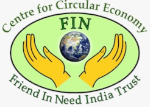
Cristina García Santos
FIN Intern – P2 Programme in Collaboration with Fusion Waste Management and Consultancy

This blog post started as a research project on entrepreneurship with flower waste showcasing two different case studies from India that give flowers a second life. Although it may seem surprising to some, flower waste is a significant environmental issue in India, where massive amounts of flowers are carried to temples every week[i]. Why do we say that it is an environmental issue? Because individuals wrongly assume that (i) flowers can be discarded anywhere, and (ii) that, given their biodegradable nature, flower’s decomposition do not entail any environmental risksi. Therefore, churches and temples throw away flower waste into water bodies. Flowers, then, decompose and deplete the dissolved o
xygen, altering the ecosystem and harming all the species living in iti. Yet, this issue is also leading to new ideas that aim at recycling and reusing flower waste.
HelpUsGreen is picking up flower waste to make compost and incense sticks in order to decrease the levels of pollution of the Ganges river. They also employing women from poor households[ii]. St. Michael’s Church, in Mumbai has installed a biogas plant to transform flower waste into cooking gas for the church’s kitchen[iii].
The objective of this research was to create an infographic displaying verifiable and contrasted data about the two case studies. The infographic showed in this blog is a preliminary version that gathers the information found in some news articles. Yet, we wanted to be thorough with the data we were using, hence we decided to contact both initiatives to verify the data we already had and ask some follow-up questions. After sending a number of emails and receiving no answer, we decided to post our questions on LinkedIn, hoping someone had some information about the case studies. This was also not useful. We tried different channels unsuccessfully with the only purpose of touching upon the issue of flower waste and support the work of these two initiatives that contribute to address this issue.
So, what started as a blog on entrepreneurship with flower waste has ended up as a blog on how all that glitters may not be gold and the difficulty of contrasting data, even when showcasing positive and relevant environmental initiatives.
All pictures used in this blog are taken from the UNEP article – a colourful solution to flower waste.
[i] Puranik, A. (2019). Moving to compost: Floral waste turns fertile ground for innovation in Bengaluru. The Economic Times. Retrieved from https://economictimes.indiatimes.com/magazines/panache/moving-to-compost-floral-waste-turns-fertile-ground-for-innovation-in-bengaluru/articleshow/71089870.cms?from=mdr.
[ii] A colourful solution to flower waste. UNEP. (2019). Retrieved from https://www.unep.org/news-and-stories/story/colourful-solution-flower-waste.
[iii] Sakaria, A. (2017). Mumbai church turns tonnes of waste flowers to eco-friendly cooking fuel. Hindustan Times. Retrieved from https://www.hindustantimes.com/mumbai-news/mumbai-church-turns-tonnes-of-waste-flowers-to-eco-friendly-cooking-fuel/story-0XteninW8OzPAOU4cCOMgO.html.

